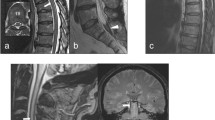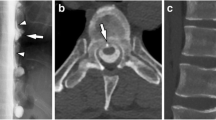Abstract
Background
Spontaneous intracranial hypotension (SIH) is a debilitating condition requiring effective treatment; however, objective data on treatment response are scarce.
Purpose
To assess the suitability of the brain MRI-based SIH score (bSIH) for monitoring treatment success in SIH patients with a proven spinal cerebrospinal fluid (CSF) leak after microsurgical closure of the underlying dural breach.
Methods
This retrospective cohort study included consecutive SIH patients with a proven spinal CSF leak, investigated at dedicated referral centre January 2012 to March 2020. The bSIH score integrates 6 imaging findings; 3 major (2 points) and 3 minor (1 point), and ranges from 0 to 9, with 0 indicating low and 9 high probability of spinal CSF loss. The score was calculated using brain magnetic resonance imaging (MRI) before and after surgical treatment of the underlying CSF leak. Headache intensity was registered on a numeric rating scale (NRS) (range 0–10).
Results
In this study 52 SIH patients, 35 (67%) female, mean age 45.3 years, with a proven spinal CSF leak were included. The mean bSIH score decreased significantly from baseline to after surgical closure of the underlying dural breach (6.9 vs. 1.3, P < 0.001). A decrease in the NRS score was reported (8.6 vs. 1.2, P < 0.001).
Conclusion
The bSIH score is a simple tool which may serve to monitor treatment success in SIH patients after surgical closure of the underlying spinal dural leak. Its decrease after surgical closure of the underlying spinal dural breach indicates restoration of an equilibrium within the CSF compartment.






Similar content being viewed by others
Abbreviations
- bSIH score:
-
Brain spontaneous intracranial hypotension score
- CSF:
-
Cerebrospinal fluid
- CSFVF:
-
CSF venous fistula
- CT:
-
Computed tomography
- FLAIR:
-
Fluid-attenuated inversion recovery
- IQR:
-
Interquartile range
- MPD:
-
Mamillopontine distance
- MPR:
-
Multiplanar reconstruction
- MRI:
-
Magnetic resonance imaging
- NRS:
-
Numeric rating scale
- ntEBP:
-
Non-targeted epidural blood patch
- SD:
-
Standard deviation
- SE:
-
Spin echo
- SIH:
-
Spontaneous intracranial hypotension
- SSS:
-
Superior sagittal sinus
References
Schievink WI, Smith KA. Nonpositional headache caused by spontaneous intracranial hypotension. Neurology. 1998;51:1768–9.
Mokri B, Aksamit AJ, Atkinson JL. Paradoxical postural headaches in cerebrospinal fluid leaks. Cephalalgia. 2004;24:883–7.
Mokri B. Spontaneous CSF leaks mimicking benign exertional headaches. Cephalalgia. 2002;22:780–3.
Schievink WI, Wijdicks EF, Meyer FB, Sonntag VK. Spontaneous intracranial hypotension mimicking aneurysmal subarachnoid hemorrhage. Neurosurgery. 2001;48:513–6; discussion 516–7.
Kranz PG, Tanpitukpongse TP, Choudhury KR, Amrhein TJ, Gray L. How common is normal cerebrospinal fluid pressure in spontaneous intracranial hypotension? Cephalalgia. 2016;36:1209–17.
Häni L, Fung C, Jesse CM, Ulrich CT, Miesbach T, Cipriani DR, Dobrocky T, Z’Graggen WJ, Raabe A, Piechowiak EI, Beck J. Insights into the natural history of spontaneous intracranial hypotension from infusion testing. Neurology. 2020;95:e247–55.
Headache Classification Committee of the International Headache Society (IHS) The International Classification of Headache Disorders, 3rd edition. Cephalalgia. 2018;38:1–211.
Dobrocky T, Grunder L, Breiding PS, Branca M, Limacher A, Mosimann PJ, Mordasini P, Zibold F, Haeni L, Jesse CM, Fung C, Raabe A, Ulrich CT, Gralla J, Beck J, Piechowiak EI. Assessing Spinal Cerebrospinal Fluid Leaks in Spontaneous Intracranial Hypotension With a Scoring System Based on Brain Magnetic Resonance Imaging Findings. JAMA Neurol. 2019;76:580–7.
Beck J, Ulrich CT, Fung C, Fichtner J, Seidel K, Fiechter M, Hsieh K, Murek M, Bervini D, Meier N, Mono ML, Mordasini P, Hewer E, Z’Graggen WJ, Gralla J, Raabe A. Diskogenic microspurs as a major cause of intractable spontaneous intracranial hypotension. Neurology. 2016;87:1220–6.
Beck J, Raabe A, Schievink WI, Fung C, Gralla J, Piechowiak E, Seidel K, Ulrich CT. Posterior Approach and Spinal Cord Release for 360° Repair of Dural Defects in Spontaneous Intracranial Hypotension. Neurosurgery. 2019;84:E345–51.
Mokri B. Intracranial hypertension after treatment of spontaneous cerebrospinal fluid leaks. Mayo Clin Proc. 2002;77:1241–6.
Kranz PG, Amrhein TJ, Gray L. Rebound intracranial hypertension: a complication of epidural blood patching for intracranial hypotension. AJNR Am J Neuroradiol. 2014;35:1237–40.
Kranz PG, Gray L, Malinzak MD, Amrhein TJ. Spontaneous Intracranial Hypotension: Pathogenesis, Diagnosis, and Treatment. Neuroimaging Clin N Am. 2019;29:581–94.
Bonneville JF, Cattin F, Bonneville F. Enlargement of the inferior intercavernous sinus: a new sign for the diagnosis of craniospinal hypotension. AJNR Am J Neuroradiol. 2011;32:E194.
Tian W, Zhang J, Chen J, Liu Y, Chen X, Wang N. A quantitative study of intracranial hypotensive syndrome by magnetic resonance. Clin Neurol Neurosurg. 2016;141:71–6.
Choi H, Lee MJ, Choi HA, Cha J, Chung CS. Intracranial structural alteration predicts treatment outcome in patients with spontaneous intracranial hypotension. Cephalalgia. 2018;38:323–31.
Brinjikji W, Savastano LE, Atkinson JLD, Garza I, Farb R, Cutsforth-Gregory JK. A Novel Endovascular Therapy for CSF Hypotension Secondary to CSF-Venous Fistulas. AJNR Am J Neuroradiol. 2021;42:882–7.
Author information
Authors and Affiliations
Corresponding author
Ethics declarations
Conflict of interest
T. Dobrocky, L. Häni, R. Rohner, M. Branca, P. Mordasini, S. Pilgram-Pastor, J. Kaesmacher, A. Cianfoni, R.T. Schär,J. Gralla, A. Raabe, C. Ulrich, J. Beck and E.I. Piechowiak declare that they have no competing interests.
Additional information
The authors Tomas Dobrocky and Levin Häni contributed equally to the manuscript.
Rights and permissions
About this article
Cite this article
Dobrocky, T., Häni, L., Rohner, R. et al. Brain Spontaneous Intracranial Hypotension Score for Treatment Monitoring After Surgical Closure of the Underlying Spinal Dural Leak. Clin Neuroradiol 32, 231–238 (2022). https://doi.org/10.1007/s00062-021-01124-z
Received:
Accepted:
Published:
Issue Date:
DOI: https://doi.org/10.1007/s00062-021-01124-z




